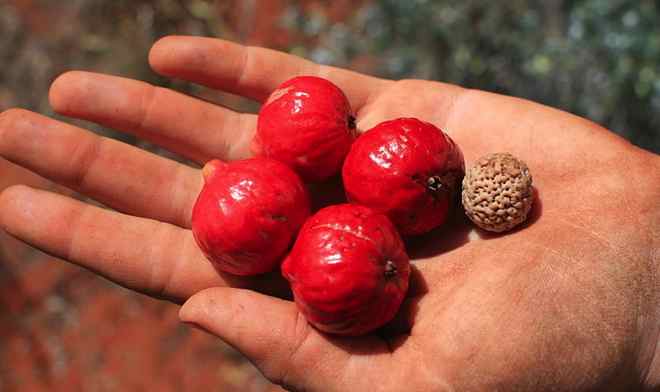For centuries, quandong has been a staple food for Australian Aboriginals. The discovery of fossilized quandongs in the coal seams of southern Victoria dates the existence of the native peach as far back as 40 million years. The ancient and hardy perennial is tolerant to long periods of drought, high levels of salinity and the harsh climate of Australia’s southwestern semi-arid regions.
The quandong tree, santalum acuminatum, grows up to eight meters in height, with pale green or grey foliage accompanied by small whitish flowers in the springtime. Distinctive red fruits about the size of raspberries are produced in abundance during the Australian summer. Interestingly for a stone fruit, quandongs are edible in their entirety; the kernel is often roasted and salted, but can also be consumed as a raw food. The flesh of the fruit itself is usually cooked, as left raw it is quite tart, like rhubarb.
Quandongs are an excellent source of protein and carbohydrate, and contain 4.2 grams per 100 grams of dietary fiber. The fruits contain twice the vitamin C of an orange and are high in antioxidants. The Indigenous peoples of Australia traditionally dried, stored and rehydrated quandongs, using the fruit pulp as a substitute for meat when needed. European settlers later used quandongs to make chutneys, jellies and tarts, many recipes for which can be found here. While the domestic market for quandongs is still in its infancy, the fruits are considered an exotic commodity overseas, with countries such as Israel attempting to establish orchards of their own.
The Commonwealth Scientific and Industrial Research Organization (CSIRO) food and crop trials on native Australian plants show that quandongs are among the top survivors and have a high-yeild potential of up to 23 kilograms per tree. The trials have identified a need for further research into horticultural production and pest and disease control, but following the success of the macadamia nut industry; there are high hopes for the future development of other ‘bush tucker’ crops on the international market. Commercial expansion of indigenous Australian species such as the quandong may facilitate the sharing of Australian Aboriginal knowledge and horticultural practices, and strengthen the platform for sustainable indigenous agriculture.
Try this quandong recipe at home!
Recipe: Quandong & Macadamia Nut Cake
Ingredients
150g macadamia nuts (finely ground)
1 jar Quandong (pureed)
2 cups of butter
1 1/2 cups of sugar
4 eggs
2 1/2 cups plain flour
6 teaspoons of baking powder
Directions
-Grease deep round cake pan and cover base with baking paper
-Blend butter until smooth and then add sugar gradually
-Beat until light and fluffy
-Add eggs one at a time, beating well between additions
-Slowly add the sifted flour, baking powder, and nut mixture
-Alternate with 1 cup of quandong puree until all combined
-Pour into prepared pan and bake at 350 degrees for 45 minutes
-Remove from the oven and spread any remaining quandong puree over the top
-Allow to cool













